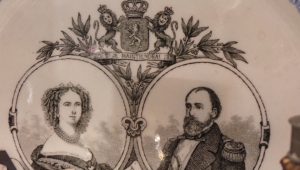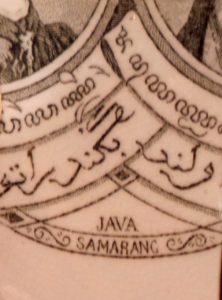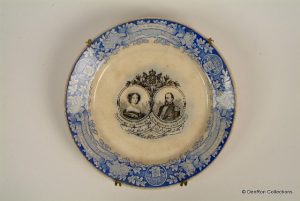
THE EARLIEST ROYAL SILVER WEDDING TO BE COMMEMORATED
The celebration of a royal wedding is a relatively recent custom. The earliest known commemoratives for a British Royal silver wedding being issued in 1888 for the Prince and Princess of Wales (Albert & Alexandra) although the silver wedding for Crown Prince Frederik and Princess Victoria of Germany in 1883 produced some mugs and beakers.
This plate must surely be the earliest and most unusual wedding commemorative to be issued.
It is an earthenware plate 25,5 cm in diameter with a transfer print decoration of King Willem III of the Netherlands (1849-1890) and his first wife Queen Sophie. All in black transfer print. Made by Societe Ceramique Maastricht.
Underneath the portraits is an inscription in Javanese and reads” Bagindo Ratu Welandi, Bagindo Mohorojo Welandi”.
The lower row is in Arabic and reads “Baginda Ratu Olanda, Baginda Maharaja Olanda” both translated in English are Her Majesty the Queen of Holland and His Majesty the King of Holland.
In the centre, between the inscriptions, the words “Java” and “Samarang” appear. Samarang is the capital of North Java.
At this time Indonesia was ruled by the Dutch.
This plate was issued in 1864, and was for sale in the Dutch Indies.
King Willem III was the father of Queen Wilhelmina. He remarried later in life to Emma of Waldeck Piermont, sister to the wife of one of Queen Victoria’s sons, Prince Leopold.
Since discovering this most unusual piece it came to light that this transfer was applied to a number of different items such as a soup dish, a meat plate and a large mug.


informatie bron: The journal of the Commemorative Collectors Society UK 1974.













